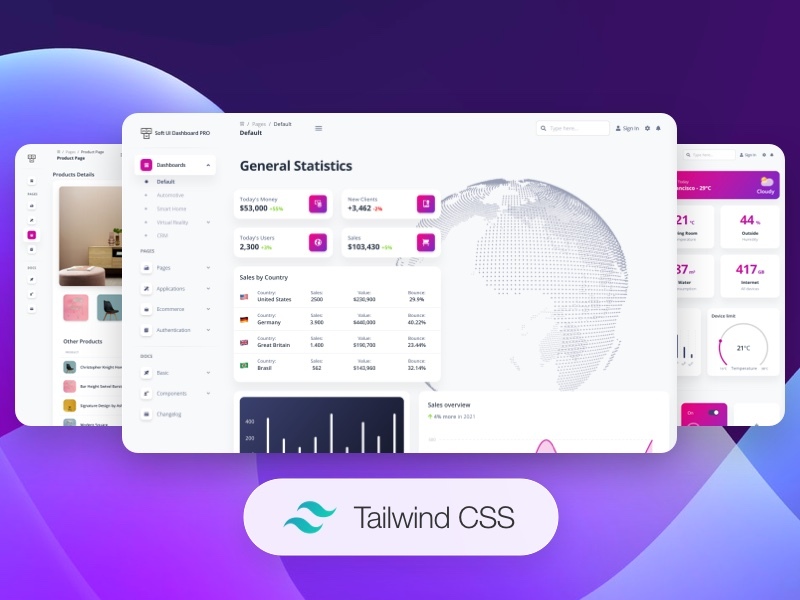Comprehensive Guide to Tailwind CSS: The Pros, Cons, and Why It's Gaining Popularity
 Rohan Shrivastava
Rohan Shrivastava
Introduction
In the rapidly evolving world of web development, CSS frameworks have become essential tools for developers.
One such framework that has been gaining significant traction is Tailwind CSS.
If you're a developer or someone interested in web design, you've likely heard of Tailwind CSS.
But what makes it so popular? Is it worth the hype?
Let's dive into what Tailwind CSS is, its benefits, potential drawbacks, and why it might be the right choice for your next project.
What is Tailwind CSS?
Tailwind CSS is a utility-first CSS framework that allows developers to create custom designs directly in their HTML by using predefined classes.
Unlike traditional CSS frameworks that provide ready-made components.
Tailwind focuses on giving you the building blocks to create your unique designs.
Benefits of Tailwind CSS
1. Utility-First Approach
Tailwind's utility-first approach means you apply small, single-purpose classes directly in your HTML.
This can drastically speed up your development process because you don't need to write custom CSS for common styling tasks.
2. Highly Customizable
Tailwind provides extensive configuration options, allowing you to customize the framework to fit your needs.
You can easily adjust colors, spacing, typography, and more by modifying the configuration file.
3. Responsive Design
Creating responsive designs is straightforward with Tailwind.
It offers utility classes for different breakpoints, making it easy to create designs that look great on any device.
4. Consistency
Using Tailwind ensures a consistent design language throughout your application.
Since you're using predefined classes, there's less room for inconsistency in your styles.
5. Community and Ecosystem
Tailwind has a robust community and a growing ecosystem.
There are plenty of plugins, themes, and resources available to extend its functionality and help you get started.
6. Fast Prototyping
With Tailwind, you can quickly prototype your ideas without worrying about writing custom CSS.
This is particularly useful for testing out new designs or creating MVPs (Minimum Viable Products).
Potential Drawbacks of Tailwind CSS
1. Initial Learning Curve
For developers used to traditional CSS or other frameworks, Tailwind's utility-first approach can be a bit challenging to grasp initially.
However, once you get the hang of it, the development process becomes much smoother.
2. Verbose HTML
Using Tailwind can lead to more verbose HTML because of the numerous utility classes you need to apply.
This can make your HTML files larger and potentially harder to read.
3. Over-Reliance on Documentation
Due to its extensive set of classes, developers might find themselves frequently referring to the documentation.
This can slow down the development process, especially for beginners.
4. Purging Unused Styles
While Tailwind provides a method to purge unused styles, it requires an additional build step.
Failing to do this can result in larger-than-necessary CSS files.
Advantages Over Other CSS Frameworks
1. Flexibility
Unlike Bootstrap or Foundation, which come with predefined components, Tailwind provides a more flexible approach.
You have the freedom to create bespoke designs without being constrained by predefined styles.
2. Performance
Tailwind's approach of purging unused styles ensures that your CSS file remains small and performant.
This can lead to faster load times and better overall performance.
3. Developer Experience
Many developers find Tailwind enhances their workflow.
The utility-first approach can make styling faster and more intuitive, particularly when working on complex designs.
Is Tailwind CSS Right for You?
Tailwind CSS is ideal for developers who:
Prefer a utility-first approach to styling.
Want a highly customizable framework.
Need to ensure design consistency across their application.
Are working on projects where quick prototyping is essential.
However, if you prefer working with predefined components or are looking for a solution with a minimal learning curve, you might want to consider other options like Bootstrap.
Conclusion
Tailwind CSS is a powerful tool for modern web development.
Its utility-first approach, customization options, and focus on performance make it a compelling choice for many developers.
While it does come with a learning curve and can lead to more verbose HTML, the benefits often outweigh these drawbacks.
Whether you're building a new project from scratch or looking to improve your development workflow, Tailwind CSS is definitely worth considering.
Subscribe to my newsletter
Read articles from Rohan Shrivastava directly inside your inbox. Subscribe to the newsletter, and don't miss out.
Written by

Rohan Shrivastava
Rohan Shrivastava
Hi, I'm Rohan, a B.Tech graduate in Computer Science (Batch 2022) with expertise in web development (HTML, CSS, JavaScript, Bootstrap, PHP, XAMPP). My journey expanded with certifications and intensive training at Infosys, covering DBMS, Java, SQL, Ansible, and networking. I've successfully delivered projects, including a dynamic e-commerce site and an Inventory Management System using Java. My proactive approach is reflected in certifications and contributions to open-source projects on GitHub. Recognized for excellence at Infosys, I bring a blend of technical proficiency and adaptability. Eager to leverage my skills and contribute to innovative projects, I'm excited about exploring new opportunities for hands-on experiences. Let's connect and explore how my skills align with your organization's goals.